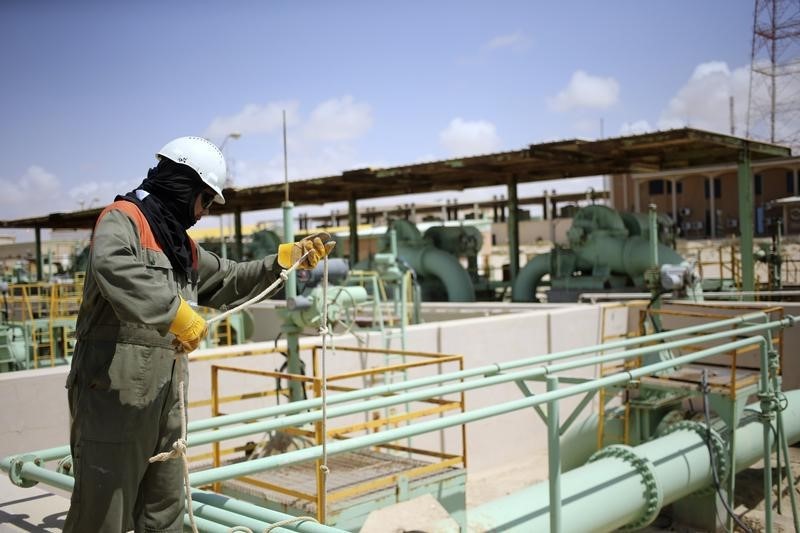© Reuters. FILE PHOTO: A tanker crosses the Gulf of Suez towards the Red Sea before entering the Suez Canal, in El Ain El Sokhna in Suez, Egypt, September 25, 2020. REUTERS/Amr Abdallah Dalsh/File Photo
By Natalie Grover, Robert Harvey and Ahmad Ghaddar
LONDON (Reuters) – Tankers carrying Russian oil have continued sailing through the Red Sea largely uninterrupted by Houthi attacks on shipping and face lower risks than competitors, according to shipping executives, analysts and flows data.
Russia has become more dependent on trade through the Suez Canal and the Red Sea since it invaded Ukraine, which led to Europe imposing sanctions on Russian imports and forced Moscow to export most of its crude to China and India. Before the war, Russia exported more to Europe.
The number of Russian ships passing through the Red Sea has registered a slight decline since December, according to oil analytics firm Vortexa, but traffic last week was still around 20% higher than on average in 2023.
That contrasted to more extensive disruptions overall to oil tanker sailings through the Red Sea in the past two weeks.
Shipments of diesel and jet fuel from the Middle East and Asia to Europe – one of the major east-to-west oil trade routes – nearly came to a halt in the days following the first round of U.S.-led retaliatory strikes on Yemen on Jan. 11, Vortexa data show.
Russia has close ties to Iran, which backs the Houthis, and that may have helped prevent attacks.
Ships carrying Russian oil for the most part have no links to Israel, the United States or Britain. The Houthis have said they are targeting ships connected to those countries in attacks to show solidarity with Palestinians in Gaza.
G7 sanctions on Russia’s oil trade over the Ukraine war contributed to rapid growth in the shadow fleet of vessels transporting sanctioned crude and fuel. Those vessels are leased by companies typically registered outside countries that have imposed sanctions on Russia. They also use maritime services and insurance from countries that do not impose sanctions.
With fewer clear connections to Western companies, those vessels are less likely to be a target.
“Most Russian crude and fuel is transported by the shadow fleet, so its unlikely going to be in the crosshairs of Houthi attacks,” said veteran oil trader Adi Imsirovic.
“The Houthis are targeting ships linked to certain countries.”
Many vessels carrying Russian cargoes are indicating they are not tied to Israel via signals from automatic identification systems (AIS) – which publicly broadcast information including a vessel’s position and destination, Vortexa analyst Mary Melton said.
Russia, a partner to key Arab powers like Saudi Arabia and the United Arab Emirates in addition to its ties with Iran, has condemned what it called the ‘irresponsible’ strikes.
Chinese officials have put pressure on Iran to rein in attacks on ships in the Red Sea and ensure those attacks do not hurt Chinese interests, Iranian sources and a diplomat told Reuters last week.
ATTACK
A Houthi attack late last week on a tanker carrying fuel which originally loaded in Russia was unlikely to impact wider Russian trade flows as that specific vessel was targeted because it had ties to British and American companies, Vortexa’s Melton said.
“The tanker had ties to both US and UK based corporate entities, so other vessels carrying Russian cargoes without these ties do not face a similar risk,” she said.
The attacked tanker Marlin Luanda is owned by Oceonix Services, a company registered in the UK to a London address, according to data from another tracking firm Kpler.
Global commodities trader Trafigura, which owned the cargo, said it was assessing the security risks of further Red Sea voyages.
Four tankers carrying Russian Urals crude passed through the Bab-el-Mandab strait with another three heading south through the Red Sea since the attack on the Trafigura vessel on Jan. 26, Kpler data show.
The flow of Russian oil should continue provided it makes economic sense and insurance cover can be procured given the level of demand from India and China, Ian Wilkinson, VP of sales excellence at Inchcape (OTC:) Shipping Services told Reuters.
Western tankers, however, will likely re-route away from the Red Sea and sail around the Cape of Good Hope, said Shefali Shokeen, a lead shipping analyst with a Dubai-based shipowner.
Either way, shippers are facing higher costs. In the Red Sea, shipowners are charging higher freight rates and crew fees, and war risk insurance premiums have surged.
Crew fees have doubled, while war risk premiums now amount to around 1% of the value of a ship, versus 0.5% about 10 days ago, excluding discounts, according to industry sources.
For instance, costs to charter 1 million barrel-capacity Suezmax ships to send Iraqi oil to Mediterranean refineries have climbed by $2.50-$3.50 a barrel for freight, while insurance has roughly tripled to between 10 and 15 cents a barrel, according to a trader with a European refiner.
The alternative route via the Cape of Good Hope adds two to three weeks to sailing time and an extra 3,300 nautical miles in fuel consumption, in addition to emissions taxes for those owned by or calling at EU states.
Read the full article here

